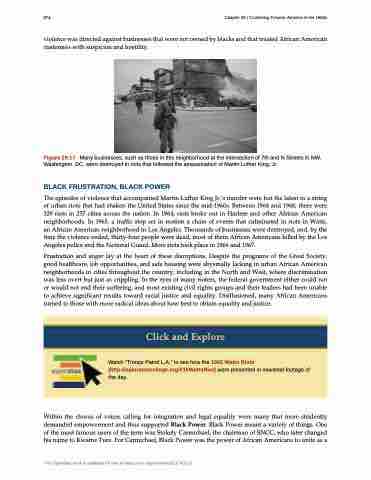Page 884 - US History
P. 884
874 Chapter 29 | Contesting Futures: America in the 1960s
violence was directed against businesses that were not owned by blacks and that treated African American customers with suspicion and hostility.
Figure 29.17 Many businesses, such as those in this neighborhood at the intersection of 7th and N Streets in NW, Washington, DC, were destroyed in riots that followed the assassination of Martin Luther King, Jr.
BLACK FRUSTRATION, BLACK POWER
The episodes of violence that accompanied Martin Luther King Jr.’s murder were but the latest in a string of urban riots that had shaken the United States since the mid-1960s. Between 1964 and 1968, there were 329 riots in 257 cities across the nation. In 1964, riots broke out in Harlem and other African American neighborhoods. In 1965, a traffic stop set in motion a chain of events that culminated in riots in Watts, an African American neighborhood in Los Angeles. Thousands of businesses were destroyed, and, by the time the violence ended, thirty-four people were dead, most of them African Americans killed by the Los Angeles police and the National Guard. More riots took place in 1966 and 1967.
Frustration and anger lay at the heart of these disruptions. Despite the programs of the Great Society, good healthcare, job opportunities, and safe housing were abysmally lacking in urban African American neighborhoods in cities throughout the country, including in the North and West, where discrimination was less overt but just as crippling. In the eyes of many rioters, the federal government either could not or would not end their suffering, and most existing civil rights groups and their leaders had been unable to achieve significant results toward racial justice and equality. Disillusioned, many African Americans turned to those with more radical ideas about how best to obtain equality and justice.
Click and Explore
Watch “Troops Patrol L.A.” to see how the 1965 Watts Riots (http://openstaxcollege.org/l/15WattsRiot) were presented in newsreel footage of the day.
Within the chorus of voices calling for integration and legal equality were many that more stridently demanded empowerment and thus supported Black Power. Black Power meant a variety of things. One of the most famous users of the term was Stokely Carmichael, the chairman of SNCC, who later changed his name to Kwame Ture. For Carmichael, Black Power was the power of African Americans to unite as a
This OpenStax book is available for free at https://cnx.org/content/col11740/1.3


